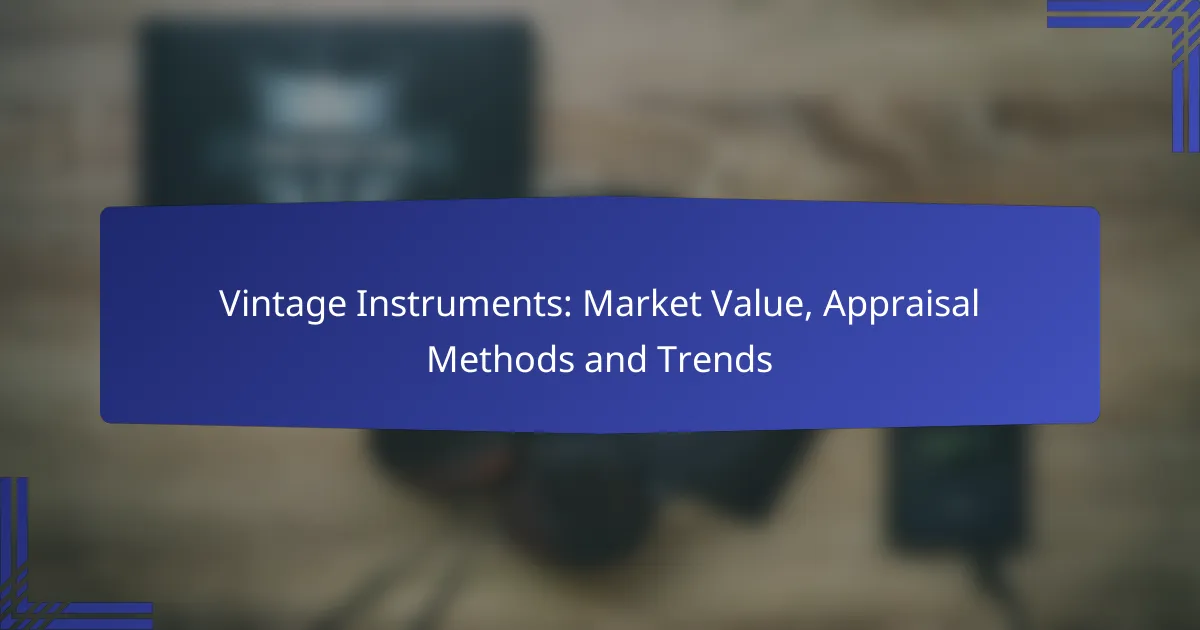Vintage instruments have become increasingly sought after, with their market value influenced by factors such as brand, condition, and rarity. Prices can range from a few hundred to several thousand dollars, with exceptional pieces commanding even higher bids at auctions. To accurately appraise these instruments, it’s essential to consider both their market value and physical condition, often with the help of professional appraisers or DIY methods. Understanding the best platforms for buying and selling can further enhance your experience in this vibrant market.
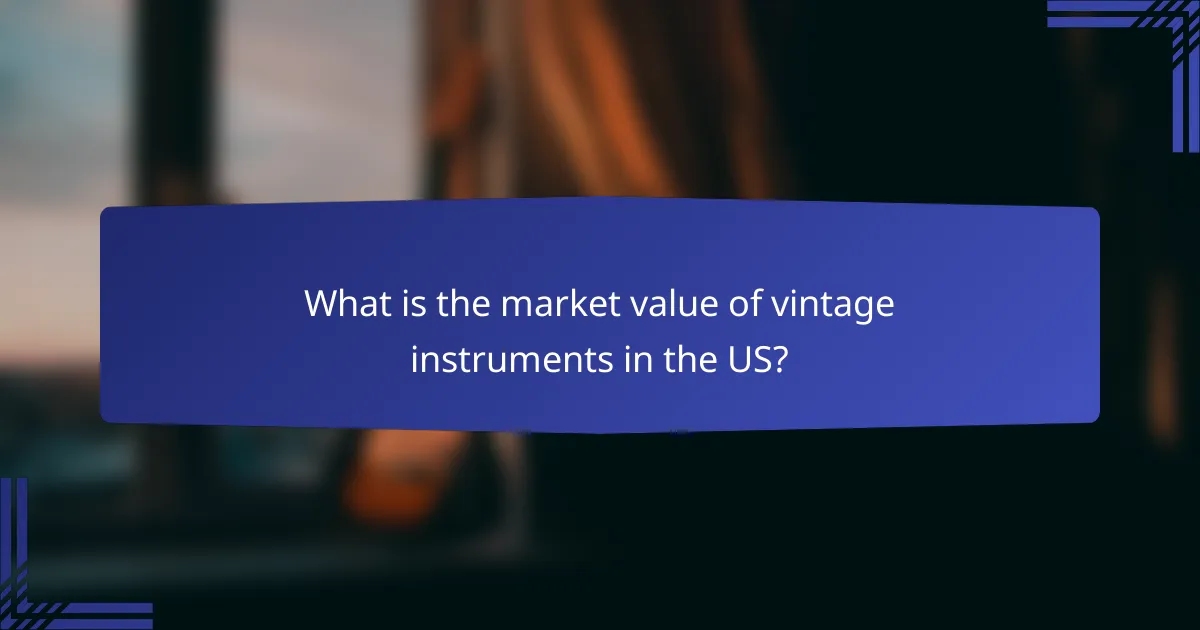
What is the market value of vintage instruments in the US?
The market value of vintage instruments in the US varies significantly based on factors such as brand, condition, and rarity. Generally, these instruments can range from a few hundred to several thousand dollars, with some rare pieces fetching much higher prices at auctions or sales.
Factors influencing market value
Several key factors influence the market value of vintage instruments. Brand reputation plays a crucial role; well-known brands like Fender and Gibson often command higher prices. Additionally, the instrument’s condition, including wear and modifications, significantly affects its value.
Rarity is another important factor. Limited edition models or those with unique features can be much more valuable than standard versions. Provenance, or the history of ownership, can also enhance an instrument’s appeal and price.
Current price trends
Current price trends for vintage instruments indicate a steady increase in value, particularly for sought-after models from the 1950s and 1960s. Instruments in excellent condition or with original parts tend to appreciate more rapidly than those that have been heavily modified or repaired.
Online marketplaces and auction sites have made it easier for buyers and sellers to gauge current values. Regularly checking these platforms can provide insights into price fluctuations and emerging trends in the vintage instrument market.
Top-selling vintage brands
Some of the top-selling vintage brands include Fender, Gibson, and Martin. Fender guitars, especially models like the Stratocaster and Telecaster, are consistently in high demand. Gibson’s Les Paul and SG models also remain popular among collectors and musicians alike.
Other notable brands include Gretsch and Rickenbacker, which have their own dedicated followings. Instruments from these brands often see competitive bidding at auctions, reflecting their desirability and market value.
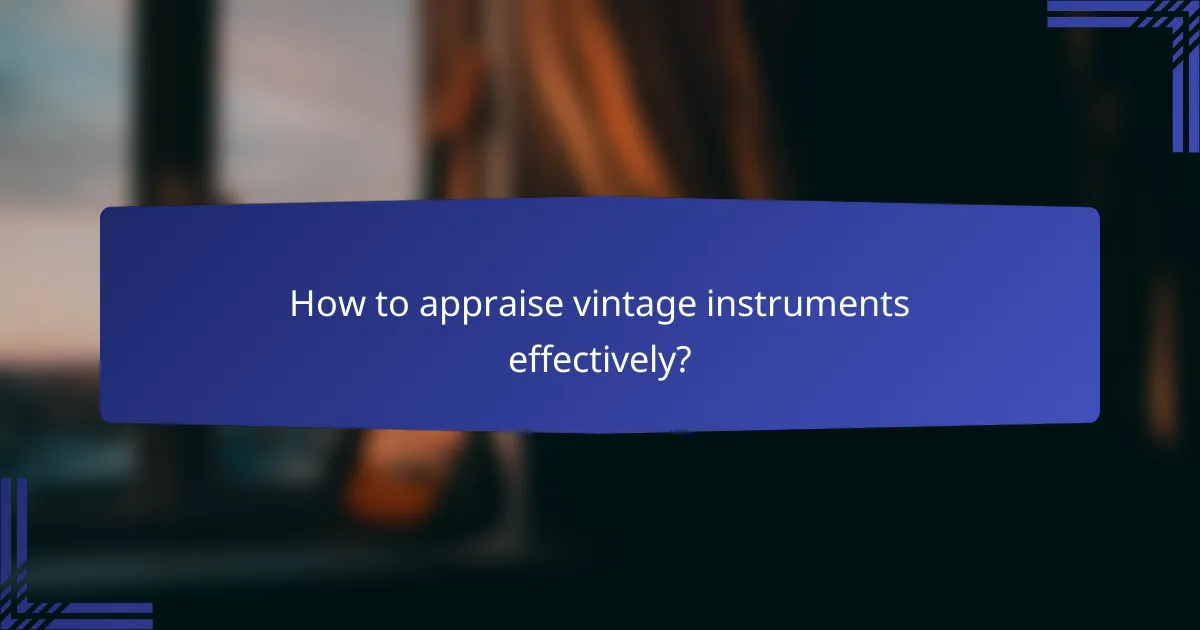
How to appraise vintage instruments effectively?
To appraise vintage instruments effectively, consider both their market value and condition. Engaging with professional appraisers or utilizing DIY methods can help you determine an accurate worth based on various key attributes.
Professional appraisal services
Professional appraisal services provide a thorough evaluation of vintage instruments, often conducted by certified experts. These appraisers consider factors such as brand reputation, historical significance, and current market trends.
Costs for professional appraisals can vary, typically ranging from $50 to several hundred dollars, depending on the instrument’s complexity and the appraiser’s expertise. A well-documented appraisal can also enhance the instrument’s resale value.
DIY appraisal methods
For those opting for DIY appraisal methods, start by researching similar instruments online through auction sites or vintage instrument marketplaces. This can give you a ballpark figure of what similar items are selling for.
Additionally, consider using online valuation tools or guides that provide average prices based on condition and rarity. However, be cautious of overestimating value based solely on online listings, as actual sale prices may differ.
Key attributes to evaluate
When appraising vintage instruments, key attributes to evaluate include brand, age, condition, and provenance. Instruments from well-known brands or those with historical significance often command higher prices.
Condition is critical; factors such as wear, repairs, and original parts can significantly impact value. Documenting any modifications or repairs is essential, as this transparency can influence potential buyers.
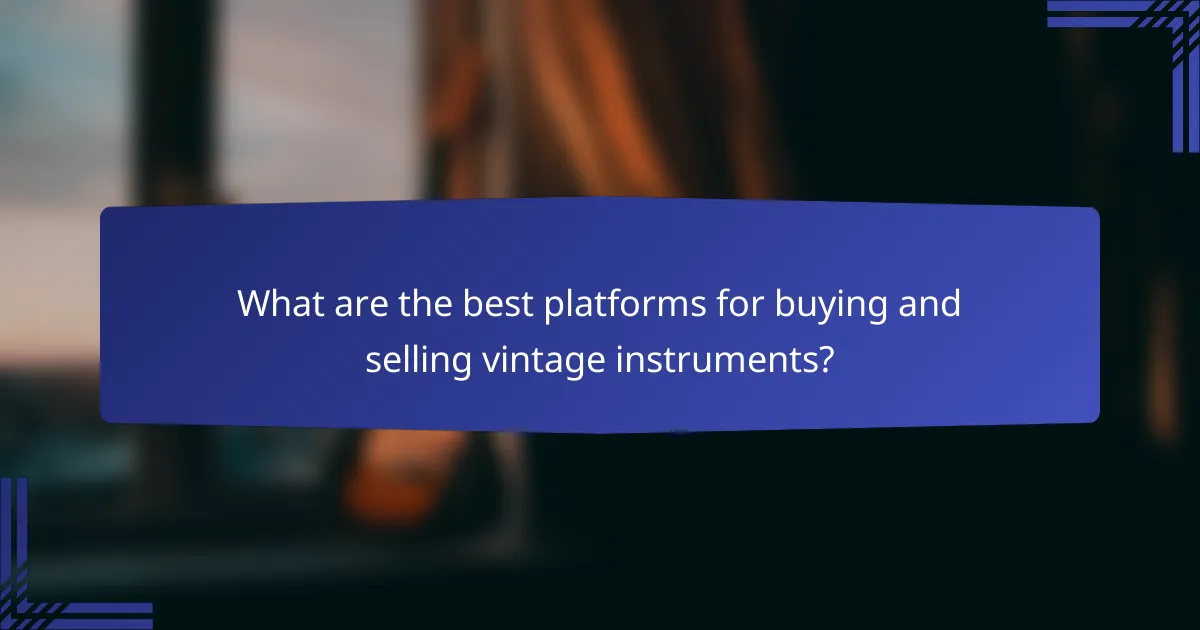
What are the best platforms for buying and selling vintage instruments?
The best platforms for buying and selling vintage instruments include online marketplaces and specialized auction houses. Each platform has unique features that cater to different needs, so understanding their strengths can help you make informed decisions.
eBay for vintage instruments
eBay is a widely recognized platform for trading vintage instruments, offering a vast selection from various sellers. It allows users to bid on items or purchase them outright, providing flexibility in pricing.
When using eBay, consider the seller’s ratings and reviews to ensure a trustworthy transaction. Be prepared for shipping costs, which can vary significantly based on the instrument’s size and weight, often ranging from $20 to $100 within the U.S.
Reverb as a marketplace
Reverb specializes in musical instruments, making it an excellent choice for vintage gear. This platform connects buyers and sellers directly, often resulting in lower fees compared to eBay.
Reverb’s community-focused approach allows for detailed listings, including photos and descriptions, which can enhance buyer confidence. Sellers should set competitive prices based on similar listings, as prices can fluctuate widely depending on demand and rarity.
Specialized auction houses
Specialized auction houses like Sotheby’s or Bonhams offer high-end vintage instruments, often attracting serious collectors. These auctions can yield significant returns, especially for rare or historically significant pieces.
When considering auction houses, be aware of buyer’s premiums, which can add 10% to 25% to the final sale price. It’s essential to research the auction house’s reputation and past sales to gauge potential value and authenticity of the instruments being sold.
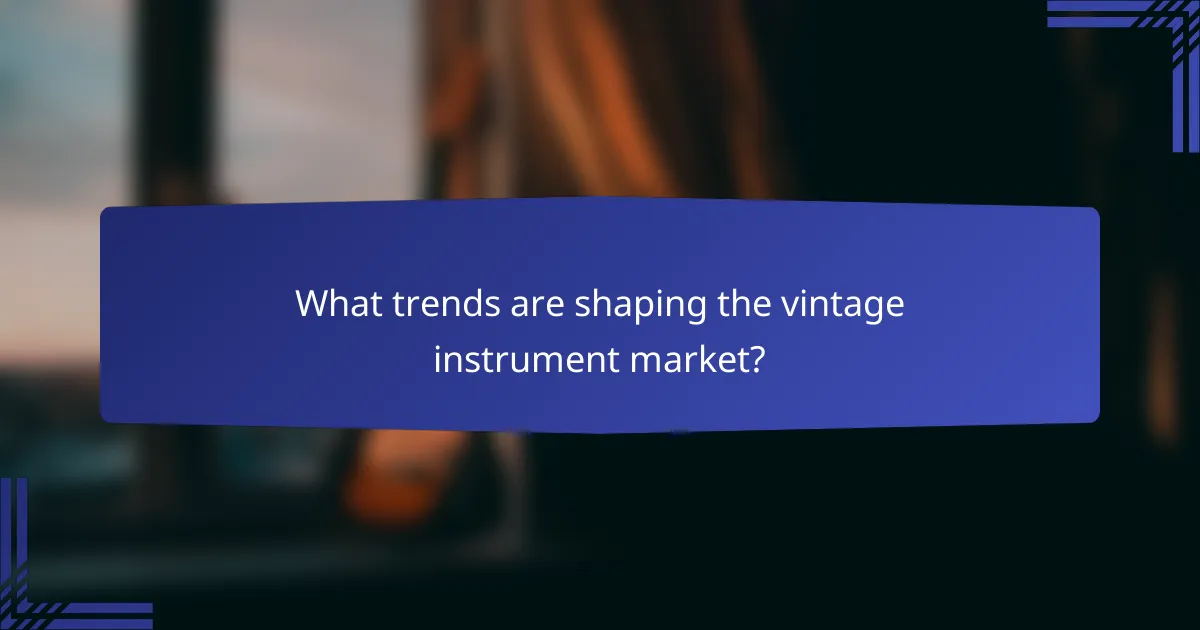
What trends are shaping the vintage instrument market?
The vintage instrument market is currently influenced by several key trends, including a growing appreciation for analog instruments, the significant role of social media in facilitating sales, and evolving demographics among collectors. These factors are driving both interest and investment in vintage musical gear.
Rising interest in analog instruments
There is a noticeable resurgence in the popularity of analog instruments, as musicians and collectors seek the unique sound and character that these instruments provide. This trend is partly fueled by a desire for authenticity in music production, where digital sounds often lack the warmth and depth of their analog counterparts.
As a result, prices for vintage analog instruments, such as synthesizers and tube amplifiers, have been steadily increasing. Collectors are often willing to pay a premium for well-maintained models, particularly those from renowned brands like Fender, Gibson, and Moog.
Impact of social media on sales
Social media platforms have transformed the way vintage instruments are bought and sold, creating a vibrant marketplace that connects buyers and sellers globally. Platforms like Instagram and Facebook allow users to showcase their collections, share knowledge, and promote sales, leading to increased visibility for rare instruments.
Additionally, online marketplaces and auction sites have simplified transactions, enabling collectors to reach a wider audience. However, potential buyers should be cautious and verify the authenticity and condition of instruments before making a purchase, as the ease of online sales can sometimes lead to misrepresentation.
Collector demographics
The demographics of vintage instrument collectors are shifting, with younger musicians increasingly entering the market. This new generation is often driven by a blend of nostalgia and a desire for unique sound, making them more inclined to invest in vintage gear.
Moreover, the rise of online communities has fostered a sense of belonging among collectors, encouraging them to share their passion and knowledge. As a result, the vintage instrument market is becoming more diverse, with collectors from various backgrounds and musical genres contributing to its growth.

What are the common mistakes when buying vintage instruments?
Common mistakes when buying vintage instruments include overlooking authenticity, ignoring condition reports, and neglecting market research. These errors can lead to overpaying or acquiring items that do not meet expectations.
Overlooking authenticity
Authenticity is crucial when purchasing vintage instruments, as replicas or counterfeit items can significantly diminish value. Always verify the provenance and seek documentation that confirms the instrument’s history and originality.
Consider consulting experts or reputable dealers who can authenticate the instrument. Look for serial numbers, labels, or unique features that align with the manufacturer’s known characteristics.
Ignoring condition reports
The condition of a vintage instrument directly affects its value and playability. Failing to obtain a detailed condition report can result in unexpected repair costs or diminished sound quality.
Request a thorough inspection from a qualified technician who can assess structural integrity, cosmetic wear, and functional aspects. Pay attention to common issues such as cracks, warping, or replaced parts that may impact performance.
Neglecting market research
Understanding the market is essential for making informed purchasing decisions regarding vintage instruments. Neglecting to research current trends and prices can lead to overpaying or missing out on better options.
Utilize online platforms, auction results, and vintage instrument forums to gauge market value. Familiarize yourself with recent sales of similar items to establish a reasonable price range and identify potential investment opportunities.
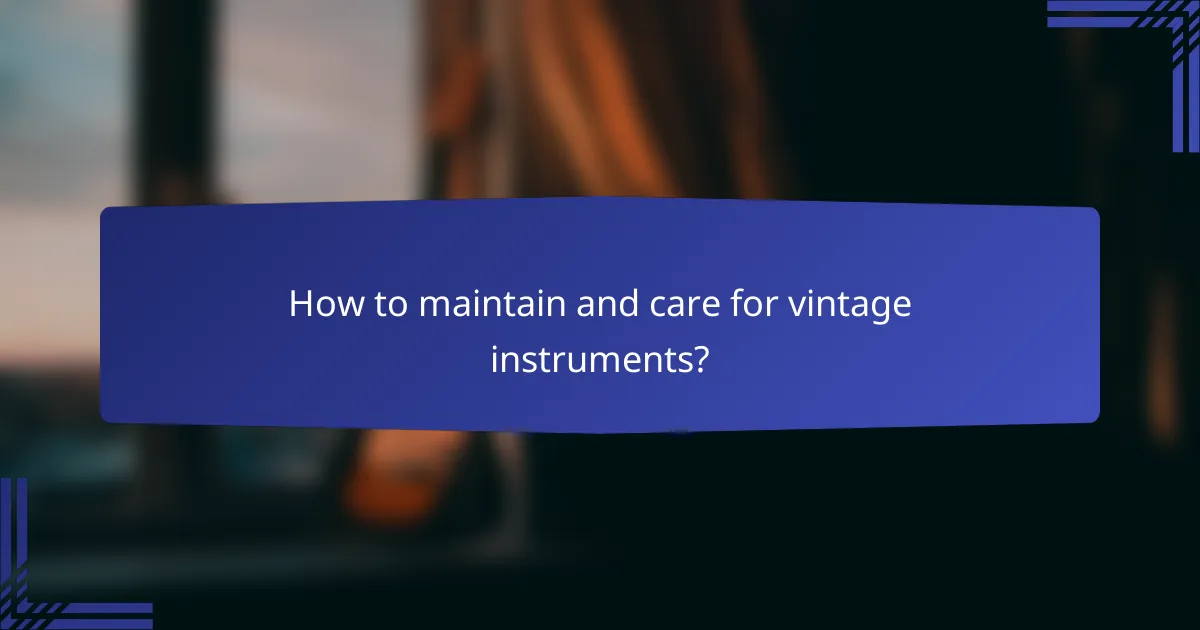
How to maintain and care for vintage instruments?
Maintaining and caring for vintage instruments is crucial to preserving their value and performance. Regular cleaning, proper storage, and periodic professional assessments can significantly extend their lifespan and enhance their sound quality.
Regular Cleaning
Regular cleaning is essential for vintage instruments to prevent dust and grime buildup. Use a soft, lint-free cloth to wipe down surfaces after each use, and avoid harsh chemicals that can damage finishes. For string instruments, consider using specific string cleaners to maintain their integrity.
For wood instruments, a light application of lemon oil can help nourish the wood, but it should be done sparingly to avoid residue buildup. Always check the manufacturer’s recommendations for cleaning products suitable for your specific instrument.
Proper Storage
Proper storage plays a vital role in the longevity of vintage instruments. Store them in a stable environment, ideally at a temperature range of 20-25°C (68-77°F) and humidity levels between 40-60%. Use a hard case for protection against physical damage and environmental fluctuations.
Avoid placing instruments near heat sources or in direct sunlight, as these conditions can warp wood and damage finishes. If possible, invest in a hygrometer to monitor humidity levels in your storage area.
Periodic Professional Assessments
Periodic professional assessments are important for vintage instruments to ensure they remain in optimal condition. Schedule evaluations with a qualified technician every few years to check for structural integrity, sound quality, and necessary repairs.
During these assessments, professionals can address issues like fret wear, bridge adjustments, and neck relief, which are crucial for maintaining playability. Keeping detailed records of maintenance and repairs can also enhance the instrument’s value over time.
